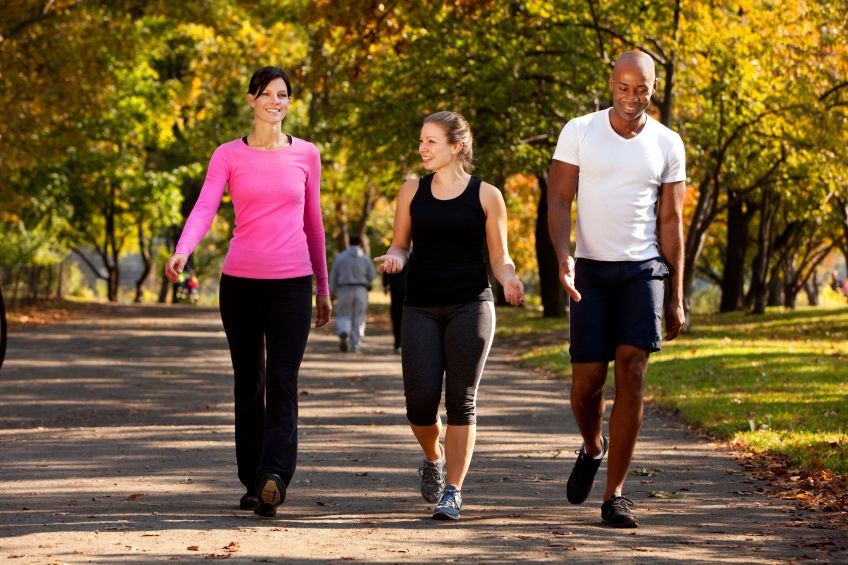Walking is a simple, effective exercise for weight loss. The number of miles needed to walk daily for weight loss can vary based on individual factors like diet and metabolism. Typically, walking one mile burns about 100 calories. To lose weight, creating a calorie deficit through a combination of increased physical activity and dietary adjustments is crucial. Today we will find out how many miles you should aim to walk each day to effectively lose weight, considering various personal health and lifestyle factors.

Contents
How Many Miles A Day To Lose Weight?
There’s no one-size-fits-all answer to how many miles you need to walk daily to lose weight. It depends on several factors, but here’s a general guideline:
A good starting point: Many sources recommend aiming for 10,000 steps, which translates roughly to 5 miles of walking. This is a good starting point for many people looking to lose weight through walking.
Factors to consider:
- Your current weight and fitness level: If you’re already quite active, you might need to walk more than 5 miles to see significant weight loss. Conversely, if you’re new to exercise, even a few miles can be beneficial.
- Your diet: To lose weight, you need to create a calorie deficit. This means burning more calories than you consume. Walking helps you burn calories, but it’s important to combine it with a healthy diet for optimal weight loss.
Benefits of Walking:
Walking isn’t just a basic routine, it’s your secret weapon for attaining holistic health. The more steps you take, the more rewards you reap. Walking offers not only impressive physical gains but also advantageous mental boosts.

- Improving Cardiovascular Health: Your heart might be more thankful than your waistline, as walking strengthens the heart and improves cardiac risk factors. Aerobic walking reduces the risk of heart disease by regulating blood pressure and sugar levels.
- Enhancing Muscular Strength: Walking doesn’t equate to pumping iron, but it does aid in toning your legs, abs, and even arm muscles.
- Promotes Weight Loss: Walking 2 miles daily could have you burning roughly 200 calories. Add that to the fact that it accelerates your metabolism, it’s an effective strategy for maintaining a healthy weight.
- Boosts Mood: Walking 2 miles a day can be just as emotionally rewarding as physically. Clocking in those daily miles may help manage depression and depressive symptoms, making it a potential remedy for the blues.
- Increases Endurance: Regular walking builds stamina and agility, which translates to better performance in various physical activities. It’s a small step in your daily routine, but a giant leap for your overall health.
How Many Calories Does a Mile Run Burn?
The number of calories burned during a mile run can vary significantly based on several factors, including the runner’s weight, speed, and overall efficiency of movement. However, a general estimate can be helpful for planning exercise and diet routines.

Factors Influencing Caloric Burn:
- Weight: Heavier individuals burn more calories due to the increased energy required to move their body over a distance.
- Speed: Running at a faster pace increases the intensity of the workout, which can lead to a higher calorie burn.
- Efficiency: Experienced runners may use less energy to run a mile compared to beginners because of better form and conditioning.
Average Caloric Burn:
On average, a person burns about 100 calories per mile when running. This is a rough estimate and applies broadly across different weights and running speeds. Here’s how weight can affect this calculation:
- Lighter individuals (e.g., 125 lbs) might burn about 85 calories per mile.
- Medium-weight individuals (e.g., 155 lbs) might burn about 100 calories per mile.
- Heavier individuals (e.g., 185 lbs) might burn about 115 calories per mile.
How to Burn More Calories While Walking?
Burning more calories while walking is an excellent goal for enhancing fitness and accelerating weight loss. Here are several strategies you can employ to increase the calorie burn during your walks:

1. Increase Your Pace:
Walking faster naturally increases your heart rate and calorie expenditure. Aim for a brisk pace where you can still talk but would have difficulty singing. This level of exertion is more likely to tap into your aerobic energy system, burning more calories.
2. Add Intervals:
Incorporate intervals of faster walking or even light jogging into your regular walks. For example, you might walk briskly for one minute, then speed up for 30 seconds, and repeat. Interval training can boost your metabolism and increase overall calorie burn both during and after your walk.
3. Use Inclines:
Walking uphill requires more energy, which means increased calorie burn. If you’re walking outdoors, choose routes with hills. On a treadmill, increase the incline for part of your walk. Even a small incline can make a significant difference in how many calories you burn.
4. Walk Longer Distances:
Extending the duration of your walks is a straightforward way to burn more calories. If you usually walk for 30 minutes, try extending your walk to 45 or 60 minutes. The longer you walk, the more calories you’ll expend.
5. Add Weight:
Carrying extra weight increases the effort your body must exert during walking. You can wear a weighted vest, carry light dumbbells, or wear a backpack with some weight. Be cautious with how much weight you add to avoid putting excessive strain on your joints, particularly your knees and hips.
6. Engage Your Arms:
Actively swinging your arms or pumping them as you walk can increase the intensity of your workout, thereby increasing calorie burn. This not only helps engage more muscles but also increases heart rate, contributing to a higher calorie burn.
7. Focus on Good Posture:
Maintaining good posture can help you engage your core and improve the efficiency of your walk. Stand tall, keep your chest up, and your shoulders down and back. Engaging your core muscles will add a slight increase in calorie expenditure and help tone your abdominals.
8. Vary Your Walking Routine:
Changing your walking route, surface, or style can challenge different muscles and prevent your body from becoming too efficient at a particular walking pattern. Try walking on trails, sand, or grass to increase resistance and calorie burn.
9. Listen to Music:
Listening to up-tempo music can unconsciously increase your pace and intensity, leading to more calories burned. Music can also make the walking experience more enjoyable and motivating, possibly extending the duration of your walk.
Frequently Asked Questions:
How does walking help with weight loss?
Walking is a low-impact, accessible activity that burns calories and aids weight loss. By starting with achievable goals, such as a daily walking routine, and gradually increasing your distance and intensity, you can burn more calories, boost your metabolism, and lose weight in a sustainable way.
Can walking help improve my overall health?
Absolutely! Regular walking can benefit your health by improving cardiovascular function, increasing muscle strength, boosting your mood, and enhancing endurance. It’s an easy, natural exercise that can contribute to better overall well-being.
What strategies can I use to burn more calories while walking?
You can incorporate several strategies to increase the calories burned during walking. These include utilizing interval training (alternating between high intensity and low intensity), adding resistance (walking uphill or using walking poles), and tracking steps or using a calorie burn calculator to monitor MET values.
What are MET values, and how do they help in increasing calorie expenditure?
MET values indicate the energy cost of physical activities and are a useful way to calculate calorie burn. Varying the intensity level of your walk and incorporating resistance can enhance your MET values and, consequently, boost calorie expenditure.
Can walking alone aid in weight loss?
Yes. Regardless of pace, walking remains an effective tool for weight loss. For instance, a 155lb person can burn approximately 149 calories walking for 30 minutes at a pace of 3.5 miles per hour. However, for optimal results, a balanced diet coupled with walking is recommended.

Santhan, known to many as Linda, combines her personal training expertise with exceptional motivational coaching skills. Her articles are not just informative but also incredibly inspiring, encouraging readers to take action and pursue their fitness goals. Linda’s unique approach to writing integrates practical fitness guidance with motivational elements, making her content both useful and uplifting.
